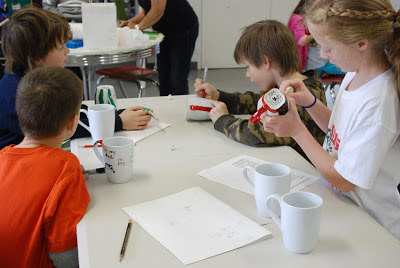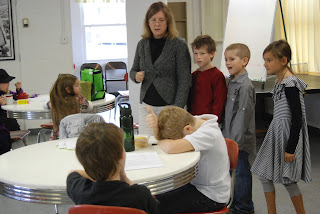 Instead of moving on the adverb phrases, I spent today driving home the adjective phrase lesson from Tuesday. We worked together, as a class, to locate prepositions in sentences, find the objects of the prepositions, and find the prepositional phrases. Then, the class ignored those phrases while we diagrammed the rest of the sentence. Finally, they diagrammed the prepositional phrases that described a noun by telling "which one, what kind, how many, or whose". We will jump back in with adverb phrases in January.
Instead of moving on the adverb phrases, I spent today driving home the adjective phrase lesson from Tuesday. We worked together, as a class, to locate prepositions in sentences, find the objects of the prepositions, and find the prepositional phrases. Then, the class ignored those phrases while we diagrammed the rest of the sentence. Finally, they diagrammed the prepositional phrases that described a noun by telling "which one, what kind, how many, or whose". We will jump back in with adverb phrases in January.
In math today, both classes continued to work through lessons on their current topic. The 4A class used what they have learned about the different types of triangles, while the 3A class worked with multiplication and division.
Writing- Each of the students worked on their individual writing assignments. Ms. Bev rotates throughout the room, helping each child with his or her needs. I don't think anyone is at the same spot, but they are all doing an amazing job and have come a long way in understanding how to construct an informative paragraph!
 Literature- In literature today, Ms. Gale and the class reviewed last week's comprehension questions. Then, they finished reading the book, "Mr. Tucket". This book was an absolute HIT! The kids loved it. There are more Mr. Tucket books, so keep on reading! After completing the book, the class enjoyed a holiday activity! They made gumdrops using droplets of water and dry Jello mix. Then, they created doughnut snowmen!
Literature- In literature today, Ms. Gale and the class reviewed last week's comprehension questions. Then, they finished reading the book, "Mr. Tucket". This book was an absolute HIT! The kids loved it. There are more Mr. Tucket books, so keep on reading! After completing the book, the class enjoyed a holiday activity! They made gumdrops using droplets of water and dry Jello mix. Then, they created doughnut snowmen! Science- The holiday fun continued, as the kids used ice to turn milk, sugar, and vanilla into ice cream! The kids worked very hard to shake up their ice cream bags. It took lots of arm muscles, but they enjoyed their sweet reward!
 Today was the last day of class before Christmas break. Instead of a party or presents, the kids collected money so that we could donate farm animals to a family in an underdeveloped country. We assumed that we could raise $100. I gave the class a list of the animals and prices. At home, they each wrote paragraphs explaining which animals they would like to donate, and why. They used all of the information they have learned so far in agriculture class to back up their selections. Today, the kids were able to read their paragraphs to the class. When it was time to take a vote, I gave them the big news. We raised twice as much as we had hoped to! Instead of voting, they were told that we could give EACH of the animals! In all, we donated a goat, 10 ducks, 2 chickens, and 2 rabbits. And, I didn't hear, "Why don't we get anything?" or "Why don't we get a party?" one single time.
Today was the last day of class before Christmas break. Instead of a party or presents, the kids collected money so that we could donate farm animals to a family in an underdeveloped country. We assumed that we could raise $100. I gave the class a list of the animals and prices. At home, they each wrote paragraphs explaining which animals they would like to donate, and why. They used all of the information they have learned so far in agriculture class to back up their selections. Today, the kids were able to read their paragraphs to the class. When it was time to take a vote, I gave them the big news. We raised twice as much as we had hoped to! Instead of voting, they were told that we could give EACH of the animals! In all, we donated a goat, 10 ducks, 2 chickens, and 2 rabbits. And, I didn't hear, "Why don't we get anything?" or "Why don't we get a party?" one single time.Today was the day of our winter garden version of Fear Factor! The class was divided into two groups : boys vs. girls. Each vegetable dish was given a different point value. Each team member could earn the points by trying (chewing and swallowing) a bite. If each team member tried a dish, then the team earned double! As I concocted this nefarious plan, I figured that an entire team might earn double points for just a few items. I mean, what is the chance that any amount of peer pressure could cause a multiple 8-10 year olds to try brussel sprouts and bok choy cabbage? Well, this is obviously a very competitive (and very brave) group of kids! Last week, one of the kids said to me, "You know what my biggest fear is? Cauliflower! But, I'm going to TRY IT!" As the game began, I was a little nervous. I just KNEW someone was going to throw up (which would, of course, lose points for your team!). Fortunately, I think adrenaline kicked in and the kids got into it!
When it was all said and done, there was only one item that didn't earn extra points: one of the brussel sprout dishes. The game included: raw carrots, sweet cooked carrots, savory cooked carrots, brussel sprouts with cranberries & feta cheese, savory roasted brussel sprouts, roasted garlic cauliflower, raw cauliflower, raw broccoli, steamed broccoli, bok choy cabbage, raw snap peas, raw spinach, spanakopita, kale chips, chocolate/kale/avocado shake, different lettuces, and spaghetti squash. I was ecstatic to hear, on many occasions, "Hey! This isn't so bad!"
In order for parents to get a sneak peek at what their kids like, or what they will tolerate, I had them list the vegetables in categories: I Like It / It's Not So Bad / I Don't Like It. In my own house, I now know I can serve raw cauliflower! They may not love it, but they will eat it! Success!




















































